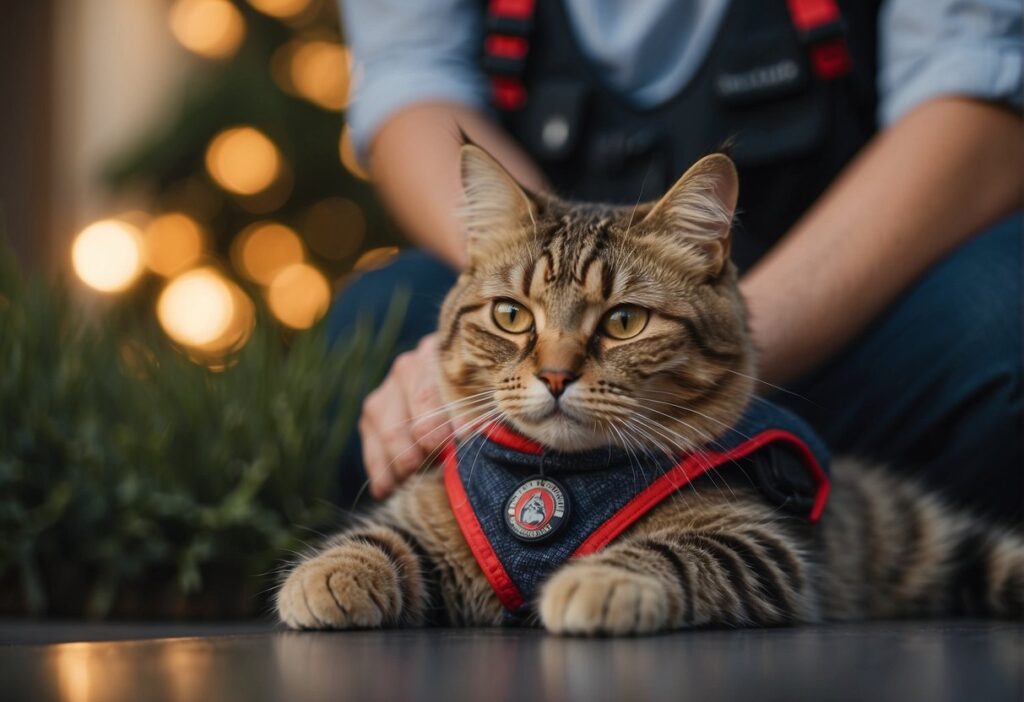When you have an emotional support cat, you might wonder whether outfitting them with a vest is a necessary step. Unlike service animals, there’s no legal requirement for emotional support animals (ESAs) to wear vests. However, you’ll find that some establishments and transport services might ask for an identifying feature to recognize your cat’s role. An emotional support vest for your cat can serve this purpose, offering a visual cue to others about your companion’s importance in supporting your mental and emotional well-being.
The role of emotional support cats is distinct from service animals as they are not trained for specific tasks related to a disability. Instead, they provide comfort through their companionship. This means that while vests can be helpful in identifying your cat as an ESA, they’re not universally required. If you’re considering a vest, it’s important to ensure that it’s comfortable for your cat to wear for extended periods, since they’ll be accompanying you in various settings. A properly fitted vest can also provide convenience, such as easy attachment points for a leash, when you take your cat in public spaces.
Basics of Emotional Support Animals
Emotional Support Animals (ESAs) play a vital role in the mental wellness of individuals facing mental health challenges, providing comfort without the need for specialized training.
Differences Between ESAs and Service Animals
Emotional Support Animals (ESAs) are not the same as service animals. While both support individuals with disabilities, they have distinct roles and legal recognitions.
- Service Animals:
- Legally defined (Americans with Disabilities Act – ADA)
- Must perform specific tasks for people with physical or mental disabilities
- Typically dogs or, in some cases, miniature horses
- Emotional Support Animals:
- Do not require ADA recognition
- Provide companionship and alleviate mental health issues through presence
- No specific task-training required
- Can be any type of animal, commonly cats and dogs
The Role of Emotional Support Cats
Emotional support cats are not just pets; they’re acknowledged for their ability to offer comfort and support for those with mental health issues. They help by:
- Offering companionship that combats feelings of loneliness or depression
- Present, but not performing tasks like therapy animals
Emotional support cats provide consistent support, helping to create a calming environment for their owners simply through their presence.
Identifying an Emotional Support Cat
Emotional support cats provide invaluable comfort, but in public spaces, it’s often necessary to distinguish them from pets. Proper identification through vests or harnesses can facilitate this process.
Vests and Harnesses for Emotional Support Cats
When out in public, your emotional support cat can wear a vest or harness to help others recognize its status. Vests for cats are typically made of breathable cotton or a similar comfortable fabric, ensuring your cat remains at ease. They come in various colors, with red and orange being common choices for visibility.
The Need for Visible Identification
Having your cat wear an emotional support cat vest serves a dual purpose. Not only does it signal to others the role your cat plays in your mental and emotional health, but it may also reduce the likelihood of your cat being mistaken for a pet in no-pet zones. Remember, the ESA vest is not a legal requirement but a helpful tool for public outings.
Choosing the Right Vest or Harness
When selecting an emotional support cat vest or harness, look for options like a kitty holster cat harness which are designed with your cat’s comfort in mind. The fit should be snug yet comfortable with adjustable straps to accommodate your cat’s size. While there’s no specific design for an ESA cat vest, ensure that whatever you choose is a clear indicator of your cat’s support status.
The Emotional Support Cat Registration Process
Registering your cat as an Emotional Support Animal (ESA) involves a certification process that recognizes the role your cat plays in your mental and emotional health.
How to Qualify for an ESA Cat
To qualify for an ESA cat, you must have a diagnosed mental or emotional disorder. A mental health professional, such as a psychiatrist, psychologist, or licensed therapist, is authorized to assess your need for an ESA. If they determine that your cat provides significant emotional support and alleviates some of your symptoms, they can issue an ESA letter on your behalf.
Understanding the Letter of Certification
An ESA letter is a formal document provided by a licensed mental health provider. It confirms that your cat is part of your therapy plan for a diagnosed mental health condition. The letter should contain the following:
- The mental health professional’s letterhead and signature
- The date of issuance
- A statement that you are under their care for a mental health disorder as per the Diagnostic and Statistical Manual (DSM)
- Confirmation that your cat is necessary for your mental health or treatment
- The type of license held by your mental health provider, their jurisdiction, and the date their license was issued
It’s important to note that while this letter does not officially register your cat in a database, it serves as a valid document for housing and travel purposes, acknowledging your cat’s role as an ESA. Remember, no additional registration is legally required.
Frequently Asked Questions
We’ve got the answers to some common questions about emotional support cats and their use of vests.
Should emotional support animals wear vests?
There is no legal requirement for emotional support animals (ESAs) to wear vests. However, a vest can signal to others that your cat is more than a pet and helps in situations where you might need to explain its presence.
How can I distinguish between a service cat vest and an emotional support cat vest?
Service cat vests often display specific patches or wording such as “Service Animal” that indicate the cat has been trained to perform tasks for someone with disabilities. In contrast, emotional support cat vests may be labeled with “Emotional Support” without implying any specialized training.
Do ESA cats require any specific training?
ESA cats do not require specialized training. Their role is to provide comfort through their companionship, not to perform specific tasks like service animals.
What qualifies a cat as an emotional support animal?
A cat is qualified as an emotional support animal when a licensed mental health professional has determined that its presence benefits your mental health. This typically requires a letter from the professional stating the need for an ESA.
Are vests or harnesses necessary for emotional support cats when in public?
While vests or harnesses are not legally necessary for emotional support cats in public, they may be helpful in distinguishing your ESA and managing them safely in different environments.











